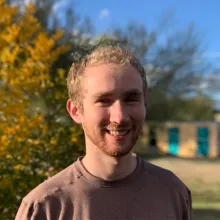
Luke Presson
A PhD in Environmental Engineering, Indige-FEWSS trainee Luke Presson describes an insightful excursion to the Navajo Nation where he helped use solar nanofiltration units to test for contaminated wells.
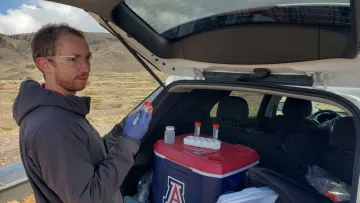
Summer Initial Reflection
This summer, I worked with the Water Resources Research Center (WRRC) at the University of Arizona as a summer writing intern. Every year the WRRC hosts a conference on a water-related topic and produces a publication called the Arroyo that communicates detailed information about the chosen topic to a wider audience. My role this summer has been to take notes on the conference, do further research, and write a first draft of the Arroyo. This year's topic was Arizona’s Agricultural Outlook: Water, Climate, and Sustainability.
My research and education focuses on urban water use and potable water reuse, so learning more about agricultural water use has given me a broader perspective. My career goal is to work on water and environmental policy for the federal government, so interacting with stakeholders in the agricultural industry as well as urban water users was particularly valuable. Finally, gaining experience communicating to a broad audience via the Arroyo will help me in my future career communicating scientific findings to policymakers.
Traineeship Highlights
My favorite experience from this year’s Indige-FEWSS traineeship was our trip to the Navajo Nation in April 2022. On the first day, we drove to Winslow, AZ, and attended a cultural training and presentation that helped us understand the best way to introduce and conduct ourselves during the trip. While we may have technically been able to satisfactorily complete the objectives of the trip without this training, I believe that it was valuable for my experience because some of the lessons learned allowed me to interact in ways that led to more thorough conversations. The next day we traveled to Dilkon Chapter to get stakeholder input on the installation of solar nanofiltration (SNF) units. Conversations with community members led us to test local wells for contaminants and gave me an appreciation for the local familiarity and knowledge of the land. One community member was able to give us a list and near-exact locations of numerous wells that needed testing. The next day we visited a family that was using one of the SNF units to disinfect their drinking water. The highlight of this section of the trip was when we were able to bring the family information about their water quality from previous water sampling trips. I was proud that we had prioritized returning to the community with information and research rather than simply taking the samples and leaving. Finally, we did some work at the community garden in Lupton, AZ, and learned more about sustaining efforts to steward the land.
This trip also highlighted how beneficial it has been to engage and become friends with the other participants in the traineeship. Throughout the year, in our seminars, trips, and social events, I have talked with students and professors from various backgrounds in different fields. In addition to all that we have learned in more formal and academic settings, the simple act of getting to know the others in the program has given me new perspectives and added drive to make my research and future career impactful.
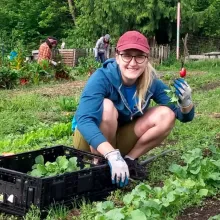
Jaclyn Rybin
Jaclyn “Jackie” Rybin (she/her) is currently an Indige-FEWSS trainee and is a Master’s student in the Department of Agriculture Education, Technology, and Innovation (AETI) at the University of Arizona. Jackie is a current intern with the STAR School in Leupp, Arizona; her project focuses on building sustainable garden spaces for Diné students, families, and the community the school primarily serves –this is her story.
My name is Jackie Rybin and I would like to share with you all about my summer internship experience with the STAR School located near Leupp, Arizona. The STAR School is a completely off-grid, community-oriented, and culturally inclusive charter school located about 25 miles northeast of Flagstaff and near the Southwest corner of the Navajo Nation. The STAR School primarily serves Diné (Navajo) youth in Preschool through 8th grades. The STAR School focuses on the interconnectedness of place-based learning through Indigenous (Diné) ways of being in the 4 R’s (Respect, Relationship, Responsibility, and Reasoning). Over the summer, I’ve been able to serve STAR school with my knowledge of gardening, farming, and planting, and been able to build relationships with school administrators, teachers, and support staff.

Photo: Jackie Rybin building raised garden beds in the STAR greenhouse.
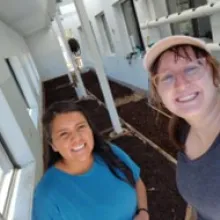
This summer, I have been able to work within the garden spaces to help clear out overgrown vegetables and weeds in order to amend the soil for new crops. Due to the COVID-19 pandemic, a lot of the previously utilized garden spaces were in need of some TLC (tender-loving care). The tending to the school’s garden spaces has been a team effort along with fellow Indige-FEWSS Trainee Intern, Chantel Harrison, and STAR School’s gardener, Mark Gross. The STAR School teachers and staff have been a great help in identifying areas to focus on this summer in order to prepare for students' return this upcoming academic year. Additionally, I’ve been able to assist with community food box distributions on the first Fridays of June and July. Here, I’ve been able to meet community members and Diné Elders in the area who happen to be the nicest folks I’ve met in awhile!
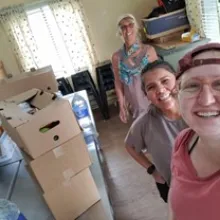
These food box distribution days have been a lot of fun with the distribution lead for the summer, Liz, and additional STAR School faculty and staff. During the summer school sessions, I was able to plant a few garden beds with students and learn about Diné food traditions from the Diné culture and language teacher, Ms. Lou. Despite planting some Navajo melon seeds before wildfires closed down the school for about a week, the students and myself were pleasantly surprised and happy to see these Navajo melons thriving in one of the previously planted garden beds. On the last day of summer school, Ms. Lou brought her students to the greenhouse to harvest sugar snap peas to be served during lunch that day. It was a lot of fun picking (and eating) these delicious sugar snap peas with students and teachers alike.

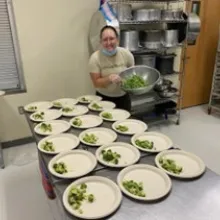
Photo, left: Jackie Rybin serving up sugar snap peas at lunchtime with Chef Cisco for STAR students and teachers. These peas were harvested by students beforehand!
Photo, right: STAR school students staying cool while planting melon seeds in the Strawbale Gardens.
My internship work has led me to primarily focus on the greenhouse space in building raised garden beds and installing a sustainable irrigation system. Fortunately, I was awarded funding through Indige-FEWSS and Coca-Cola grants for additional building materials, soil amendments, and irrigation system supplies to help assist with the greenhouse infrastructure project for the school. I’m very thankful for the support Indige-FEWSS has provided for this summer project experience, especially Dr. Karletta Chief. This internship experience has been very unique in how it has allowed me to practice community-oriented, action-led work on site at the STAR School. Coming from academia this year, it has been wonderful to be afforded the opportunity to build genuine, reciprocal relationships with the STAR School administrators, teachers, staff, students, and community, and to utilize my connections with the University of Arizona to help make farm-to-school gardening infrastructure a reality.
It is my hope that future academics stem their research projects in a way that directly serves Indigenous communities and aren’t afraid to “do the work” needed to make ideas come to fruition. Even though building these raised beds has been a lot of labor, I’ve really enjoyed working with the STAR School gardener, Mark Gross, and using my hands to become proficient in building garden beds with power tools!
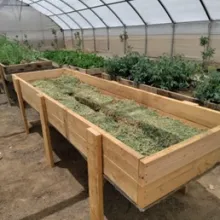
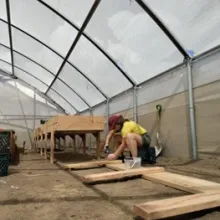
Photo, left: Jackie Rybin building raised garden beds in the STAR Greenhouse.
Photo, right: A finished raised garden bed!
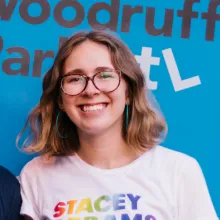
Ruth Pannill
Ruth Pannill is a current IndigeFEWSS trainee and is a Master’s student in the School of Natural Resources and the Environment at the University of Arizona. Here, Ruth details her summer experience working with Arizona Project WET as a Water Educator, teaching with TCUP at Diné College, and participating in the Climate Reality Training. She recounts work in the field, bonding with other trainees, and attending a workshop at the STAR School. Click below to read her story!
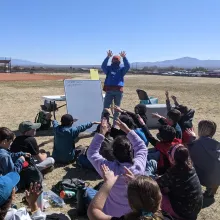
This summer has been a whirlwind of learning, growing, teaching, and collaborating with my fellow trainees. While I have worked with Arizona Project WET since January 2022 as a Water Educator through Americorps, I was able to continue my work with them this summer updating curriculum, attending teacher trainings, and preparing for the new group of incoming Water Educators. Going forward I will be diving deeper into my work on place-based and inclusive water curriculum. I will be continuing my work with Project WET and collaborative efforts with Indige-FEWSS for my Master’s Project in the coming school year, and am looking forward to being back in the classroom.
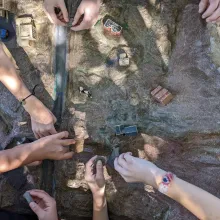
The highlight of the summer was teaching Water Modules with the amazing Water Team for the Tribal College & University Program (TCUP) at Diné College. We lectured and learned about water quality, contaminants, and many environmental justice issues that are woven into water in our world. We were also able to do hands-on water quality activities using handheld equipment as well as the solar nanofiltration (SNF) unit that Indige-FEWSS has worked with the community to develop. In June, a group of us attended the Climate Reality Training in Las Vegas, NV, which was a time full of discussing worldly realities, bonding with my fellow Indige-FEWSS trainees, and connecting with folks from across the region and world that are doing great work for the planet. Finally, I attended a teacher training workshop at the STAR School in Leupp, Arizona, and was able to assist some of my fellow trainees with their projects at the school. This summer has been full of incredible experiences and opportunities, and I’m very grateful to Indige-FEWSS for making it all possible.
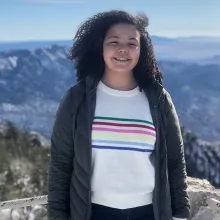
Sarah Abney
Indige-FEWSS Trainee Sarah Abney describes her summer experience with her second TCUP workshop, the Climate Reality Conference, a Food Bank in the Los Angeles area, and Reading Partners. Click below to read her story!
Summer Reflection
This summer I have had the wonderful opportunity to participate in my second TCUP workshop. Rather than last year's virtual setting, we were able to journey to Tsaile, AZ, where Diné College is, and teach in person. This was an amazing experience because in addition to co-leading and teaching parts of the Water Team curriculum, we were able to bring the SNF unit for demonstration and we were able to collaborate with other professors on campus during our down time. This included a forestry class and a student spirit week event that we were invited to during that week. It was very heartwarming to receive feedback from the students as some recounted how the training workshop really motivated them in their career and in helping their local community. Not too long after TCUP, I headed to the Climate Reality Conference with many of my peers for an unforgettable week of networking with our appropriate regional groups and impactful people. Although there was an essence of equitable environmentalism, it was very apparent, having freshly returned from Tsaile, that there is much to do in the fight for climate change and equitable change at that. Throughout these trips with my cohort, I was fortunate to serve as a consultant at an international pro-bono sustainable development firm, Impact Consulting. Throughout the summer I was assigned to a project helping a Food Bank in the Los Angeles area get more volunteers following the lessening of social distancing rules. Due to unforeseen reasons with the client, the project ended early, but I was fortunately reassigned and promoted to an Engagement Manager where I am leading my own consulting team on a similar volunteer marketing issue, but with a national children’s literacy non-profit, Reading Partners. This opportunity has been impactful in my career journey as a consultant and has opened my eyes to the varying ways that sustainability can improve many sectors of our life outside of food, energy, and water directly, and to the power of education.
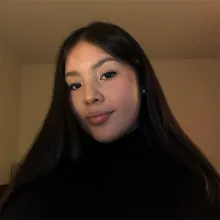
Veronique Arguello
Veronique is working as an Indian Energy Program intern at Sandia National Labs (SNL) in the 20-year-long program. Her research and projects during her internship focus on strategic planning for Tribes. She learns and works closely with other Native and Indigenous folks in energy development, the Department of Energy Indian Energy Office, and SNL professionals to discuss projects focused on creating renewable and clean energy. Click below to learn about her experience!
Summer Reflection
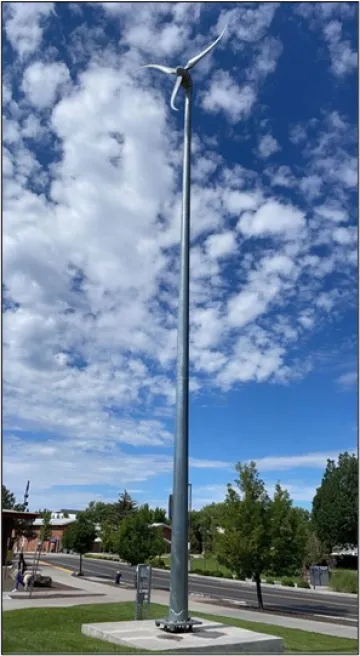
I recently visited Flagstaff, Arizona, to speak with founders and employees of Native Renewables, Deb Tewa and Suzanne Singer. It was an incredible experience to have the opportunity to have conversations about PV installments and clean energy with Tewa and Singer in their head of operations. And just like any other field visits, we all shared great ideas, food, and laughs. My internship has more field visits in store for me in the future.
May 2022-June 2022 - Tribal College University Program (TCUP): I had the opportunity to visit the Tsaile, Arizona, Diné College campus with peers and professors in the University of Arizona Indige-FEWSS program. I was a part of the Water Team in the Food, Energy, and Water modules. I presented personal and relevant cases about environmental justice and indications of the water quality of the Navajo Nation. This was a new experience for me to be in front of the classroom presenting information and data to other students in a more formal manner. I felt like my experience as a Native woman in higher education gives me a position of understanding familiar environmental injustices when it comes to other Native and Indigenous folks. I feel like it is a cycle of reciprocity to share my experiences and knowledge with others who are interested in learning more about it, and I learn in the same experience because the students have questions, thoughts, and additional information on the subject. This teaching experience was a reminder that there is a vast amount of knowledge keepers in the food, energy, and water systems.
June 2022 - Climate Reality Project: I had an engaging experience at the 2022 Climate Reality Project Training in Las Vegas, NV. At the training, I met folks who led research and careers in clean energy, Tribal sovereignty, and climate change readiness. A highlight of the training was hearing about the City of Las Vegas and Clark County, Nevada, Sustainability and Climate Action Plan from Clark County Commissioner Jones.
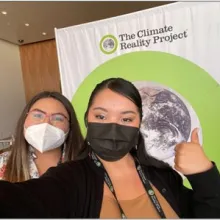
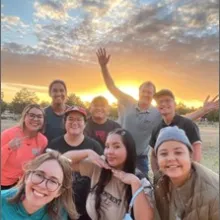
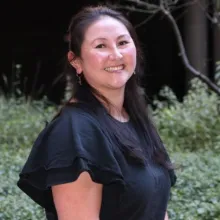
Chrisa Whitmore
Chrisa Whitmore is a PhD student in the Biosystems Engineering program at the University of Arizona. She reflects on her time in the IndigeFEWSS program and her opportunities, including teaching at Diné College and attending the Climate Reality Project. Click below for more!
Summer Reflection
My experience with Indige-FEWSS was wonderful. I got to connect with so many people in the university and around the southwest region that are connected by the tenants of Indige-FEWSS. I was immersed in the Indigenous culture throughout this experience and have had a once-in-a-lifetime opportunity to learn what I can do to help address food-energy-water challenges. I especially loved being a part of teaching at Diné College. It is my passion to be able to talk about the subjects that I love, and I hope to inspire the next generation of scientists. I had the opportunity to attend the Climate Reality Project with Dr. Chief and it has inspired me to keep going on my journey toward being a scientist. From the amazing friendships I've made with the trainees, to the valuable intercultural awareness I've gained and will continue to grow, I've loved every minute of being a trainee.
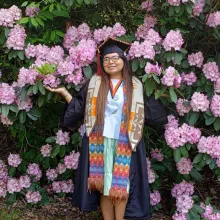
Nizhoni Tallas
Nizhoni Tallas is a PhD student in the School of Natural Resources and the Environment at the University of Arizona. Here, Nizhoni reflects on the highlights of her IndigeFEWSS experience, including an immersion trip to Dilkon, Arizona, participation in the Native FEWSS Alliance Conference, and outreach work with tribes. Click below for more!
The NSF Research Traineeship (NRT) program seeks proposals that explore ways for graduate students in research-based master’s and doctoral degree programs to develop the skills, knowledge, and competencies needed to pursue a range of STEM careers. Nizhoni reflects on the highlights of her IndigeFEWSS experience, including an immersion trip to Dilkon, Arizona, participation in the Native FEWSS Alliance Conference, and outreach work with tribes. Click to watch!
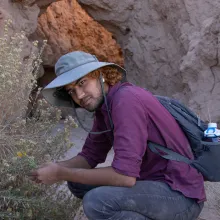
Kunal Palawat
Kunal Palawat (they/she) is a PhD student in the Environmental Science program at the University of Arizona. They work with the NRT/Indige-FEWSS program to study the intersections of pollution, community-based research, public health, and environmental justice. Here, Kunal reflects on their summer on Saint Croix in the US Virgin Islands working with the Critical Ecology Lab. Click below for more!
The NSF Research Traineeship (NRT) program seeks proposals that explore ways for graduate students in research-based master’s and doctoral degree programs to develop the skills, knowledge, and competencies needed to pursue a range of STEM careers. Kunal reflects on their summer on Saint Croix in the US Virgin Islands working with the Critical Ecology Lab. Click to watch!
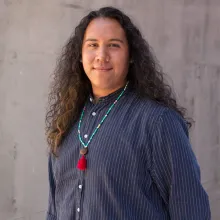
Tony Viola
Tony Viola (He/They) is a Doctoral Student in Teaching, Learning and Sociocultural Studies. He is from the Pascua Yaqui Nation and worked on the San Xavier District Climate Resilience Project.
Summer Reflection
This summer I had the opportunity to be a Graduate Intern for a collaborative and ongoing project between the San Xavier District of the Tohono O’odham Nation and the School of Natural Resources and the Environment at the University of Arizona. The San Xavier District Climate Resilience Project is focused on enhancing the adaptive capacity to the effects of climate change that will impact the San Xavier District. Pending approval from the Internal Review Board of the Tohono O’odham Nation, the project core team will conduct a rapid climate assessment of assets and vulnerabilities found within the District. Community members, especially youth, will play a vital role as their voices are intended to be at the forefront as they co-lead and co-develop the project. In lieu of starting and completing the rapid climate assessment this summer, project leaders were able to work with me to provide a unique experience that was still beneficial and informative in the meantime.
My most memorable and grounding experience has been engaging with O’odham community members and learning about the culture-based, creative, and unique climate-focused projects that are ongoing across the Nation. When first joining the team, I attended a virtual cultural sensitivity training provided by the Tohono O’odham Nation’s Tribal Historic Preservation Office. Led by Cultural Resource Specialist and Elder Knowledge Holders, I learned about the sacred plants and landscapes that have shaped this community’s culture since time immemorial. Teaching on how to respectfully engage with the Land as a visitor and follow the protocol and ethics of the community were the very backbone of the training. In addition to the cultural landscape, we learned about current threats that challenge it, such as long-lasting destruction to sacred ceremonial and burial sites from the border wall construction, not far separated from the challenges of climate change - both human-led and fed by colonialism.
To better inform my role and responsibilities as a core team member, I was able to visit environmental and agricultural projects that have been ongoing for decades or were more recent developments. The San Xavier Cooperative Farm, the Reclaimed Mine Site, and the Tohono O’odham Community College’s West Campus Agricultural Extension Program, although spread out in different areas, are connected by one key factor. They each demonstrate the efforts of community members to reclaim, heal and return to traditional ways of being with the land, all while navigating and preparing for a continuously changing climate. Through these tours, presentations, and dialogues I was able to hear from community members firsthand their passion for the work and what they hope to see come from their efforts.
The San Xavier District Cooperative Farm is a staple that many non-Indigenous and Indigenous people in the greater Tucson area are somewhat familiar with. We were given an all-inclusive tour that spoke to the history of the farm, along with their role in the community of providing traditional crops as well as modern crops to support livestock practices across the district. As one might imagine, our conversations included topics of the Dawes’ Act, allotment, population growth from the surrounding cities, sacred rivers running dry, and so on. On the brighter side, the day we visited, the Farm staff had begun the drying phase of the cactus fruit they had recently harvested. An ancient tradition was ongoing at the Farm and products were available for purchase to anyone at the farm store! To me, the San Xavier Co-op farm represents many things. Among them are community efforts to heal land sectioned and separated through allotment, a return to traditional foods to live healthy and balanced lives, and an educational space free of classroom walls.
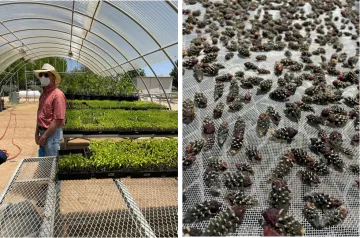
Photo, left: Dr. Garfin in a repurposed hoop house. Photo, right: Cactus fruit being dehydrated by the desert Sun.
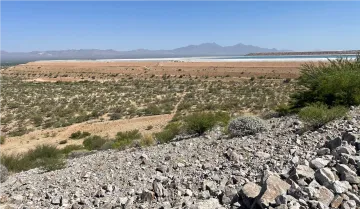
Looking from the reclaimed mine site to active mining in the distance.
Another experience specific to the San Xavier District is the reclaimed mine site that has been in a process of rematriation with the Land. This was one of the most breathtaking moments of my summer internship as I had never visited a mining site prior. We should all know the devastating toll mining takes on our natural resources, especially Indigenous land and sacred sites across the country. Even when the mining has stopped, the harm continues for decades through health hazards and a reluctance to clean up the area. Reflecting now, I cannot help but think of the Gold King Mine Spill of 2015 and the ongoing battle Apache Stronghold is in to save the sacred site of Oak Flat from Resolution Copper. The power of this reclaimed mine site rests in the fact that it not only demonstrates a tribal community’s efforts and investment to heal a mined site, but it is also that just across the street that marks the reservation boundary, a massive and active mining complex continues. Juxtaposed across from one another, the reclaimed and active mining sites naturally lead to a conversation of reservation boundaries limiting efforts, and intrinsically force a call to action to prevent further harm from mining, one of the most protected and unlimited industries in the state that has some of the worst environmental impacts, disproportionally impacting Indigenous Peoples and other marginalized communities.
Another first for me this summer was visiting a tribal college or university. The team from the Agricultural Extension Program at Tohono O’odham Community College’s (TOCC) West Campus welcomed us with open arms as we were eager to learn about their ongoing projects. Starting with a tour, we saw first-hand how they have grown their rainwater harvesting practices and natural water catching efforts, such as watching how the water flows from monsoon floods and mapping out the terrain to work with, not against the water. With fields appearing empty, tiny leaves from young corn plants were eagerly popping through the desert soil to also welcome us. Our group came at a time when numerous renovations and new developments were underway in preparation for the next school session where students, apprentices, and interns would soon fill the space. After a presentation on the numerous community partnerships and extensive education efforts underway at the west campus, we also shared about intertribal differences and similarities that are impacting our natural landscapes and traditional practices across the state of Arizona. On another inspirational visit, I was fortunate to see how this campus and overall tribal education institution engages in capacity building with their students, low-cost stewardship efforts, and educational experiences ranging from small children to Elders.
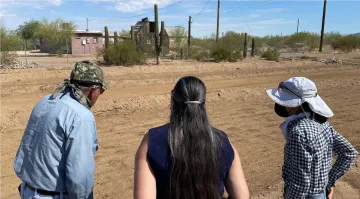
TOCC Agricultural Extension Program staff talking about planting practices.
Learning from and with community members has undeniably been a priceless foundation to prepare members of our team for assessment-specific work in the future. I am grateful we were given the time and space to engage in these unplanned but much-needed kinship-building and knowledge-seeking practices. Outside of these tours and conversations, other components of my summer internship involved interpreting federal and academic studies for community transmission and use in the future. For example, I worked with Professor Garfin and graduate student Charmaine Leonidas to take the Lower Santa Cruz River Basin study as a starting point to situate the San Xavier District in the larger conversation through drafted handouts and outreach materials to potentially use in the future. Additionally, I was able to work with staff from the Natural Resources Department of the San Xavier District to offer consultation and advice on educational activities and presentations. From climate-based icebreakers to use at district-wide department gatherings and debrief activities for a youth-focused land defenders conference, I am thankful to have been a part of the overall process. Pending IRB approval in the near future, I look forward to continuing with this team to start the assessment, specifically helping to oversee the Climate Resilience Youth Ambassadorship along with community engagement sessions.
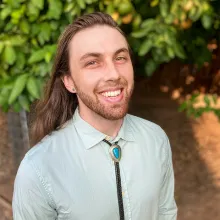
William Borkan
William Borkan is a Master’s student in the Department of Environmental Science at the University of Arizona. Here, he reflects on his summer experience with the IndigeFEWSS program. William discusses his pursuit of scientific communication, preparation for graduation, getting married, and working with the Contaminant Transport Lab. Click below to read more of his story!
Summer Reflection
Indige-FEWSS has taught me that I am capable of pursuing goals that foster beneficial and lasting community partnerships. It is from this core lesson that I have poured myself into this career. Between 2021 and 2022, I have worked hard to develop a strong scientific background steeped in science communication and community-based participatory research. My future goals are based on this methodology as well: study pervasive contaminants in the environment to protect access to safe foods and clean drinking water. My partner and I are working towards moving to the Navajo Nation in the coming years so I can use the tools I have been developing to create real change for communities who want it. It is vital to continue this work focused on community engagement and collaborative research at the core alongside more rigorous scientific research.
This summer began with a huge amount of wedding preparation. My partner and I spent the first month of summer in Flagstaff, Arizona, coordinating vendors and family to make sure our wedding was as stress free as possible. It was worth the effort!
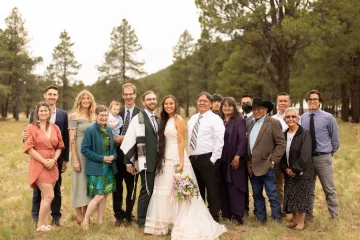
Our immediate families (Photo taken by Sherrie Logg)

Us leaving the ceremony space (Photo taken by Sherrie Logg)
Now that the wedding is over, I am working diligently on my Master’s thesis and have plans to graduate in the fall. My efforts in the Contaminant Transport Lab have been both challenging and fruitful. We have one complete set of data from a geochemical experiment on a superfund site’s aquifer sediments, and now we are working with the machine shop on campus to build a flow cell to measure hydraulic properties of the aquifer. I have a timeline to finish everything by early October, allowing myself extra time so that my other projects can be completed during the semester as well.
In addition to working on my thesis research, I have accepted a role as researcher for Dr. Brusseau to study the transport and fate of “forever chemicals,” also known as PFAS, or per- and poly-fluoro alkyl substances. Multiple sites around Tucson have contamination from these chemicals and are seeking collaboration with our lab to help assess the spread and future treatment of them.
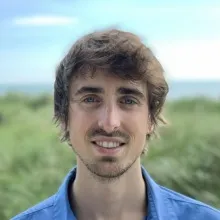
Calder Bethke
Calder Bethke is Master’s student in the Biosystems Engineering program at the University of Arizona. In his reflection, he discusses his summer internship at Sixth World Solutions and his experience practicing mutual aid and learning about Hoop Houses.
Click below to read the whole story!
Calder’s Summer Internship Reflection: Sixth World Solutions
This summer has gone by very fast. I’ve been interning at Sixth World Solutions, an organization on the Navajo Nation that does work in food security and sovereignty, among many other things. I was joined in the internship by two students from Fort Lewis College, and it was led by Sixth World Solutions Co-Founder Kern Collymore. For the first month we visited farms and families and gave a helping hand, as well as learned new techniques regarding tilling, planting, transplanting, weeding, and other farm and garden duties. We also witnessed and practiced a lot of mutual aid in the communities, with people helping and gifting things to us in return. It reminded me a lot of my Traditional Ecological Knowledge class at UA that prioritized relationships and relational living.
We also visited several Hoop House greenhouses and learned how farmers are using them here and what issues and successes they’ve had with them. One of the successes is that it can be hard to grow leafy greens out in the open because it is so windy on the Navajo Nation, but the Hoop Houses, covered in shade or plastic, are able to protect leafy greens and other sensitive plants.
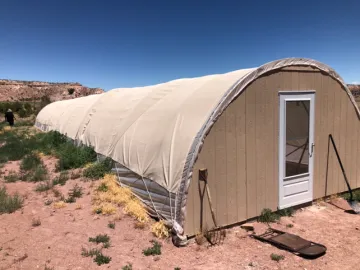
Visiting the Hoop Houses was a great experience for me because I study controlled environment agriculture at UA. We helped put on shade cloths, create garden beds, transplant, and weed in the Hoop Houses. We learned that one of the issues in the Hoop Houses is that they can get very hot and it can be difficult to ventilate and control their air temperature, and that these issues can be stressful and time-consuming to manage. I have some experience with sensors and automation using microcontrollers, and figured that for part of my internship project I could try and help add a temperature alarm and data collection system, as well as try to get funding for some solar power setups and exhaust fans for these Hoop Houses.
Many Hoop Houses are outside the standard Wi-Fi and Bluetooth range from a home, and most commercial products do not have temperature alarms or data collection. The temperature alarm and data collection setup I want to build would have a sensor in the Hoop House and would send that temperature to the home using a radio transmitter. A microcontroller in the house would create an alarm if the temperature was too high or low, as well as use a special Wi-Fi chip to send this data online, where someone could access it via the BLYNK app on their smartphone, and review the data as well as receive notifications if the Hoop House was too hot or cold.
Overall, I’ve really enjoyed the internship so far. I will be here until mid-August and am really excited to see the crops mature and see the fruits of all our labor.
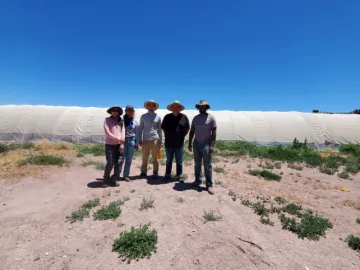
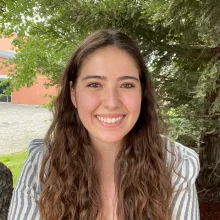
Arianna Tariqi
Arianna Tariqi is a PhD student in the Chemical and Environmental Engineering program at the University of Arizona. Here, Arianna reflects on her time with IndigeFEWSS and discusses her internship at the Yuma Desalting Plant, attendance at the Climate Reality Training, and an immersion trip to the Navajo Nation. Click below to read her reflection!
Arianna’s Reflection
As I reflect back on my time in IndigeFEWSS, the word connection is a great word to encompass my feelings and experiences in this traineeship. As summer is ending, I am overwhelmed with the quality and quantity of relationships I have made throughout my time. I was able to attend immersion trips, conferences, and seminars that have helped me build a deeper connection to the environment whether through lessons in the classroom or working hands-on in the field.
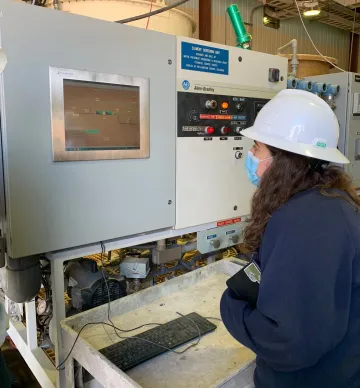
This summer, I had an internship that helped me develop professional skills that will be extremely useful as an IndigeFEWSS trainee as well as an environmental engineer. Through existing partnerships, I was able to work at the Yuma Desalting Plant in Yuma, AZ. Having done plenty of research on this specific plant already, I was ecstatic for the chance to work in one of the largest inland desalination facilities. Getting to walk through the plant and see all the equipment that I had spent months researching, right in front of me, was unbelievable. During my time at the plant, I helped analyze samples in their lab for a summer contest that the Bureau of Reclamation holds. This competition aims to recover more drinkable water from a concentrated salt stream. I was surrounded by many skilled engineers, technicians, and operators who taught me about the different functions and tasks they did on the daily. I was able to speak with contestants about their water treatment skids they created while also working in the lab where I would help analyze the samples from the competition. Working in the lab taught me a lot about data management, organization, and how to use lab instruments. When I wasn’t working physically at the plant, I was working with data from a system at the plant where I would model, organize, and analyze the numbers and present it at meetings. Overall, this internship experience was extremely valuable to my future goals as an environmental engineer working in the water sector. Working at a desalting plant has helped me understand technical aspects of water treatment technologies that will help me on my journey to assisting communities facing water insecurities.
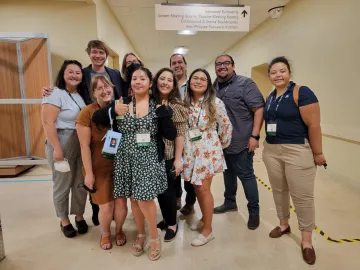
Over the summer, trainees and I were also invited to attend the Climate Reality Training hosted by former Vice President Al Gore. This training entailed presentations, mentoring, and panels, including one that Dr. Chief was a part of, throughout the 3 days. It was a privilege to see so many accomplished women and young people speaking on panels. I learned that there are some really great initiatives happening right now for climate, and many that were started by the younger generation. While I learned a lot, I also recognized that many people are still catching up to the issues that people around the world are facing. While climate change is a daunting topic, I felt motivated to continue working in this field. I realize the importance in educating those around us on issues that affect us and the environment while being unafraid to stand up for those important issues. The group conversations we had gave me hope for the future.
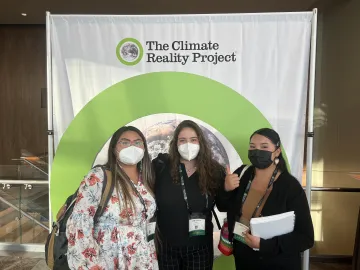
As summer comes to an end, I reflect on my time as an IndigeFEWSS trainee this past year. I am so grateful for all the opportunities I was able to take part in. I attended some of the most impactful trips that have shaped the researcher I want to be. As an engineer interested in researching solutions to water insecurity, this traineeship helped open my eyes to ways in which I can make my research meaningful and feasible to communities. I took part in two immersion trips in October and March. I was able to help collect samples of water both from the community’s supply and from running the solar nanofiltration units (SNF) systems the families used for treating their water. Grateful would be an understatement to describe how honored I have felt to be a part of these trips and to be trusted into the space of others’ homes. The connections I built with humans and the environment while traveling with my trainees and advisors have made a big impact on me that will last a lifetime.
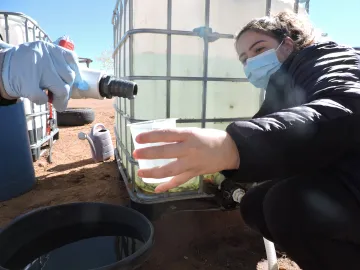
My time in IndigeFEWSS was a huge learning opportunity where I had a wide array of opportunities to participate in activities that interested me and informed my work. While being in the field, I learned how to be adaptable to change, prepared, and organized. I practiced how to listen better, to learn more, and also to unlearn a lot of western ways of doing. Dr. Chief’s passion and the relationships I built with my fellow IndigeFEWSS peers have motivated me in my pursuit to obtain a PhD. Once a trainee always a trainee!
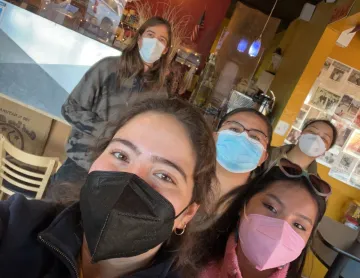
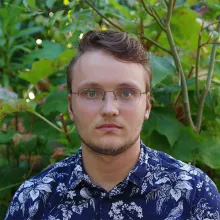
Anton Samoylov
Anton Samoylov is a PhD student in the Chemical and Environmental Engineering program at the University of Arizona. Here, Anton reflects on the highlights of his summer working with TCUP and participating in an internship at GVI. He also recounts the highlights of his traineeship with IndigeFEWSS, including a trip to the STAR School, IndigeFEWSS seminars, his favorite class in the minor, and an Alternative Spring Break at Biosphere 2. Click below to read his story!
Summer Highlights
1. TCUP Training and Trip
One of the most obvious highlights of this entire year, including summer, was the weeklong trip undertaken by the IndigeFEWSS trainees up to Diné College to participate in teaching the annual TCUP FEWS modules. Being a part of the Energy team, I gained valuable knowledge during my preparation into the applicational workings of photovoltaic arrays including their positioning, factors affecting efficiency, and sizing considerations.
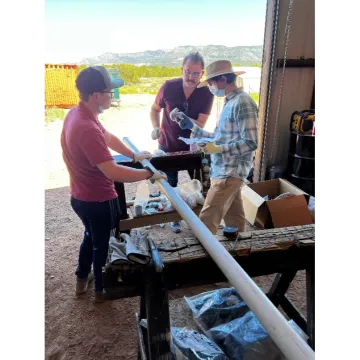
Photo courtesy of Jaymus
I greatly enjoyed my stay at the College, where I participated in their open house events held during the week, contributed to the greenhouse building efforts led by Professor Kacira at the Land Grant Office, and got to interact with the local students.
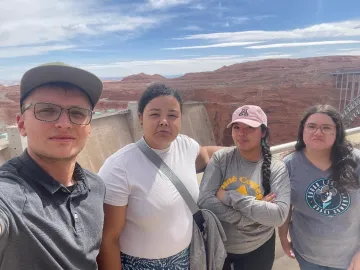
One of the most important parts to being able to visit the Navajo Nation in person was to see in person some of the challenges being talked about during the traineeship. I was deeply impressed by the distances between various places and witnessed the sparse access to grocery stores, and how spread out everything in general was. I’ve heard a lot about these challenges in the confines of a classroom, but seeing these kinds of things in person left a completely different grasp on what these challenges looked like. Hearing personal anecdotes and challenges faced by various students in the TCUP program related to FEWS also helped me get an idea of what kinds of roadblocks existed with proposed technologies.
2. GVI Internship
Although it has been tough balancing the internship with my research, I’ve been learning a lot about working internationally with various cultures and time zones, as well as the inner workings of funding startups, the various funding mechanisms involved, and the various stages of development of a startup and the resources available at each step.
Traineeship Highlights
1. STAR School Trip
Similarly to the TCUP trip, this was actually one of my only trips getting near to the Navajo Nation. Although I had no existing connections to the educational efforts being led by Dr. Chief, Dr. Simmons-Potter, and other faculty alongside Mark Sorensen, the director of the STAR School, I was intrigued by the conversations taking place regarding some of the challenges in the current curriculums and educational systems on/around the Navajo Nation.
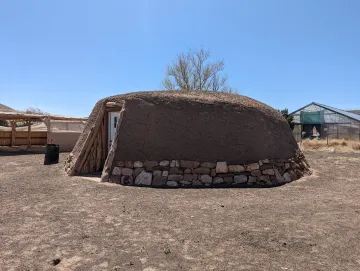
I’ve found this to be another great cultural experience as well since we got to visit a very traditionally built hogan and be inside of it. Learning more about the practices adopted by the STAR School for complete off-the-grid sufficiency helped get an idea of strategies that organizations and communities can employ on their way to a more sustainable future. Last but not least, it was great to witness one of the solar nanofiltration buses in person at the STAR School, used for demonstration purposes across various communities.
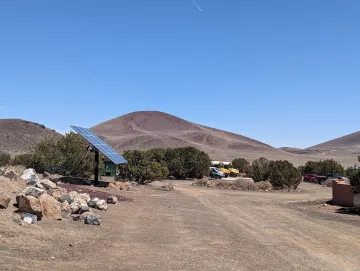
2. NVIS Seminars
The collection of NVIS seminars has also been a great learning experience being an IndigeFEWSS trainee! Helping with the setup and introduction of a couple of these seminars, I got the chance to talk with some of the speakers, as well as listen to the Q&A discussions afterwards. These talks added more depth to my interdisciplinary education at this traineeship.
3. AIS 541A – Native Resource Management
This must be one of the most impactful IndigeFEWSS minor classes to date that I have taken. This class was a particular highlight for me due to the expertise in Russia-inhabiting Indigenous Peoples brought by Dr. Ben Colombi. Coming from Russia as an immigrant, learning about the challenges faced by Indigenous Peoples of Siberia, the Kamchatka, and other regions of Russia, hit particularly close to home. Being a large fan of nature and the outdoors brought some well-appreciated insights into the current struggles of Indigenous communities to preserve and reclaim stewardship over valuable natural resources and landscapes.
4. Biosphere 2 Alternative Spring Break
Biosphere 2 was a fantastic opportunity to do outreach to the Honors College students at the UofA about the work that our traineeship does. The ropes course activities and round table discussions helped facilitate conversation amongst the trainees, as well as induce a greater sense of comradery overall between the cohorts.
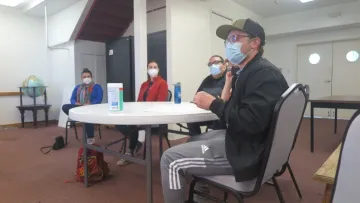
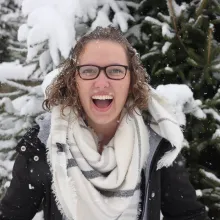
Anna Rich Hamstra
Anna Rich Hamstra is a PhD student in the Chemistry and Biochemistry program at the University of Arizona. Here, she details her summer activities and time as an IndigeFEWSS trainee. She discusses her internship at the Functional Materials and Advanced Coatings Laboratory at the University of Calgary in Canada and getting to know the Calgary community. Anna also recalls her favorite classes and the friends she made through the IndigeFEWSS program. Click below to read her reflection!
Reflection of Summer Activities and Traineeship
This summer I am interning with the Functional Materials and Advanced Coatings Laboratory at the University of Calgary in Canada. I am working under Professor Gregory Welch working on characterizing perylene diimide interlayers as applied to organic photovoltaics. Organic photovoltaics have exciting advantages such as being low-cost, low-weight and solution processable, which makes them a great option for integrating into buildings and in remote communities. My day-to-day life consists of going to the lab and performing experiments such as UV-VIS spectroscopy and atomic force microscopy, or making organic photovoltaics using both the spin coating and slot die coating techniques. In this lab, I collaborate with people from all over the world, from Canada, USA, Pakistan, Iran, Ghana, China, and Brazil. During this summer, I also had the opportunity to attend the 2022 Canadian Chemistry Conference and Exhibition which was held in Calgary this year. At this conference I met other chemists working in the renewable energy fields and expanded my professional network. The following picture is of my coworkers and I at lunch during the conference.
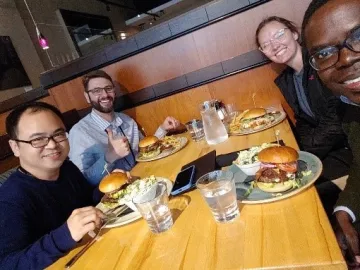
In addition to learning and working with organic photovoltaic devices in the lab, I am also learning things within the Calgary community. This past week, I attended the Calgary Stampede, which is known as the “greatest outdoor show in the world”. It had a rodeo, horse shows, dog shows, agricultural information stations, and an Indigenous campground which is where I got to learn about some of the First Nations. The Elbow River Camp honors the First Nations of Canada by celebrating the cultures of the Kainai, Piikani, Siksika, Stoney Nakoda, and Tsuut’ina First Nations. At the Elbow River Camp, there were 26 Tipis where members of the different nations actually camped and shared their culture during the 10-day Calgary Stampede.
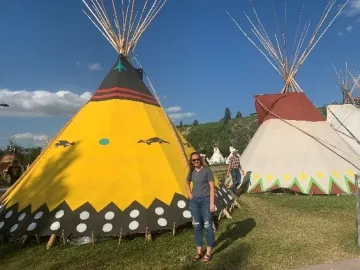
I am so grateful for the Indige-FEWSS traineeship because it has made my graduate school experience more interdisciplinary, collaborative, and unique. I have really enjoyed the additional classes that I took, such as the Indigenous Natural Resource Management class and the Applied Solutions at the FEWS Nexus class. Both of these classes taught me things I would not have learned through my traditional chemistry graduate career and helped me expand my knowledge on the big picture of my research. Through the traineeship I also met wonderful friends who I enjoyed learning from their different cultures and I met some future collaborators.
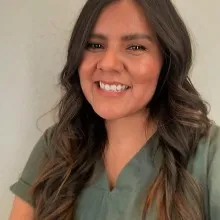
Chantel Harrison
Chantel Harrison is a Master’s student in the Applied Biosciences program at the University of Arizona. Her educational and career interests include contributing solutions that address food sovereignty, food insecurity, and the food-energy-water nexus in urban and rural Indigenous communities. Here, Chantel reflects on her summer experience working with the STAR School to improve efficiency and food production. She discusses her favorite aspects of the collaboration and how it has set her up for the 2022-2023 academic year. Click below to learn more about her experience!
Indige-FEWSS Internship - STAR School
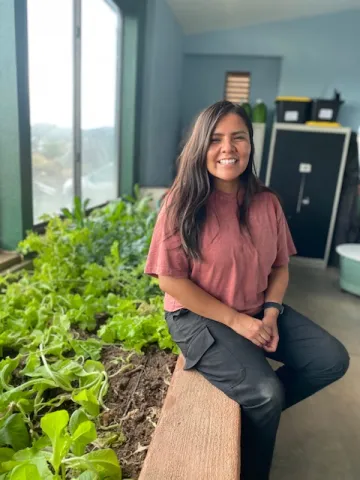
For my NSF Indige-FEWSS internship, I collaborated with STAR “Service to All Relatives” Charter School located near Leupp, AZ. STAR School serves Pre-K through 8th grade students who live in the southwest corner of the Navajo Nation and the surrounding area. STAR School focuses on acknowledging and interacting with all relatives – land, water, plants, animals, rocks, sun, and wind, in ways that demonstrate respect, responsibility, and reasoning. As part of their mission and values, STAR School has multiple greenspaces for students, staff and families to plant, harvest, and gather. In addition to the traditional in-ground garden spaces, the campus houses a hydroponic and aquaponic system.
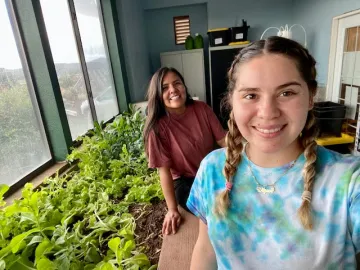
My primary focus during the summer was to update the current hydroponic and aquaponic systems to improve the overall efficiency and increase food production while incorporating STAR School values. The second focus of my projects was to increase accessibility and user-friendliness of each system to encourage teachers and staff to incorporate the hydroponic and aquaponic systems in science curriculum and extra-curricular activities. My third focus included updating the space where the aquaponic system is located. Due to COVID-19, the space had not been used in a few years and needed a deep-clean, reorganization, and new paint. Additionally, with support from Dr. Chief, we were able to purchase a seed germination rack, stainless steel tables and horizontal air fans to increase plant production within this greenspace. The new goal of this space was to transform it into an Indigenous Food Lab which would be a space to sow seeds, transplant vegetables into the hydroponic and aquaponic systems, or a place to relax and connect with plant relatives. I also wanted to prepare this space as a safe and clean environment to demonstrate nutrition-related science activities, such as food safety through implementing protocols for harvesting and washing vegetables and herbs that will be served in the school meals. Lastly, we purchased two new hydroponic 2-Tower Farm Walls with lights to replace the hydroponic system. The new hydroponic towers will allow STAR School to grow fresh leafy greens and herbs throughout the year with the option to be operated by the middle-school classrooms.
Overall, I have enjoyed my time at STAR School. I have gained new skills and knowledge in my field of study through working with the current hydroponic and aquaponic systems. I have also learned new skills that are not related to my studies, such as caretaking of koi fish and chickens. Most importantly, the interactions with staff and students were the most memorable part of this experience. From sharing meals at lunch time, chatting during breaks, and staff helping with the larger tasks, I felt welcomed and incorporated in the micro-culture and community of STAR School. As a Diné person, I also felt a sense of home through the landscape and the Diné culture that is integrated throughout campus. As the upcoming academic year approaches, I am excited to start a new project at UA based on my experience at STAR School that focuses on food sovereignty and educational opportunities through controlled environment agriculture.
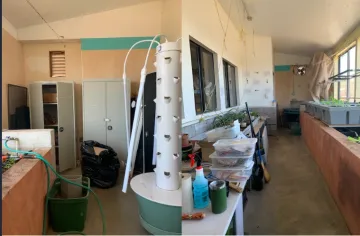
STAR School Before Pictures
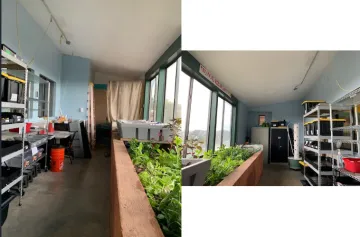
STAR School After Pictures
